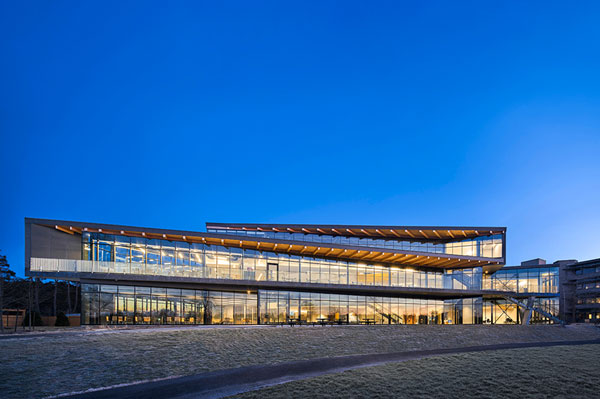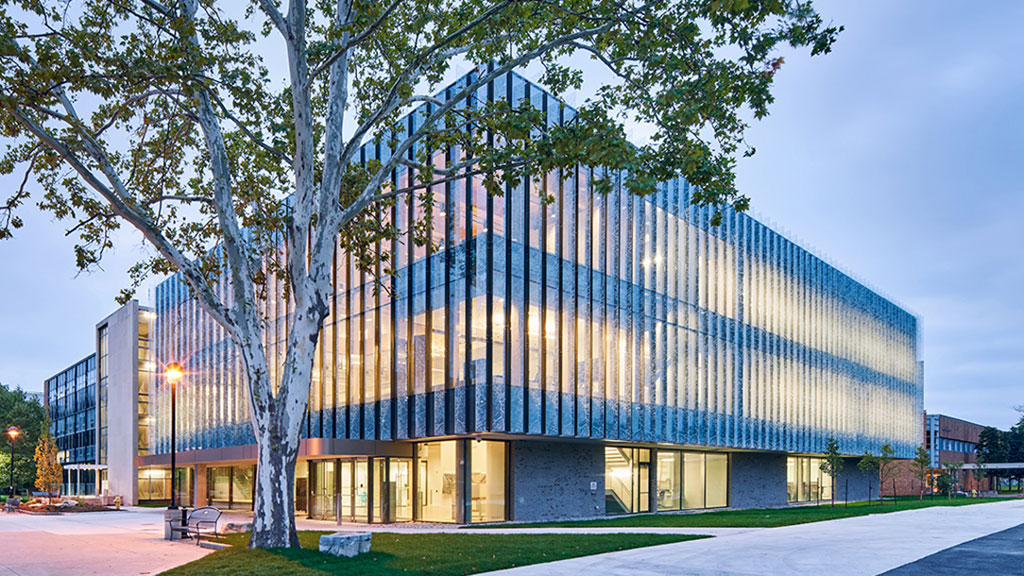In an award program unlike any other in its history, the Ontario Association of Architects (OAA) honoured the 10 winning recipients of its 2020 Design Excellence Awards in an Oct. 1 virtual showcase of its celebration of excellence.
A major highlight was naming the winner of a People’s Choice Award, in which 2,135 members of the public voted for their favourite project, choosing from 10 in an online poll conducted after the OAA had announced the winners.
That honour went to the University of Windsor’s new Essex Centre of Research, which was designed by Hariri Pontarini Architects and houses the physics, chemistry and biology departments. The project features highly functional and unobstructed floor plates.
In its submission, the Toronto architectural firm described the centre as a “jewel amongst the aging infrastructure of the university” and one that tells the story of science at the institution.
Finding a way to celebrate architects
Presented on a variety of platforms, including the OAA’s YouTube channel, webpage and Facebook, the program also acknowledged a number of service award winners. Some projects received both awards.
Normally, the celebration is a major feature of the OAA’s annual conference in May. Of course, this year’s conference was cancelled because of the pandemic.
“However, the OAA Awards program is very important to us, and we knew we also had to find a way to celebrate the architects and practises that were being honoured this year,” says association president Kathleen Kurtin.
Although the transition to a virtual format required major adjustments, there were tangible benefits. OAA members from across the province were able to watch and going digital allowed first-time public viewing, which was free and required no registration, she says.
Noting that the pandemic required resiliency by society at large, Kurtin says the design excellence projects are an example of another kind of resiliency, “one that comes with creating beautiful spaces in which people can live, work, and play, while respecting the environment and acknowledging the need for long-term performance to address our climate change crisis.”
Addressing climate change
Addressing climate change was the catalyst for another change that differentiated the 2020 program from previous ones.
For the first time, a demonstrated use of Energy Use Intensity (EUI) metrics was required on all the submissions. EUI is the amount of total energy a building uses per square metre per year.
Sustainable design is no longer a specialty, but rather a critical component of all building projects, says Kurtin in explaining that condition.
Presented on a biennial basis, the awards are intended to provide a forum for Ontario architects to present their work to both the public and the profession, even if the buildings they designed aren’t in Ontario.
A five-member jury of design and architecture experts selected the 10 winning projects from 79 submissions using criteria such as creativity, context, sustainability, business and legacy.
Canadian winners
Included in that top list, besides the Essex Research Centre, was the Borden Park Natural Swimming Pool in Edmonton, the Trent University Student Centre in Peterborough, Ont., and two projects in the United States.

Located in one of Edmonton’s oldest parks, Borden Park is Canada’s first chemical-free public outdoor pool. Designed by Toronto-based gh3*, it uses a technology that cleanses the water through a combination of stone, gravel, sand and a botanic filtering process.
Overlooking Peterborough’s scenic Otonabee River, the Trent University Student Centre was designed by Teeple Architects to strengthen the relationship between the students and the river and connect the students with each other.
Oriented to take advantage of heat gain in the winter is the south and east facades, its green features include natural ventilation by way of a large three-storey forum and high performance curtain wall glazing.
American projects among the winners
Toronto-based KPMB Architects was the designer of the two American projects. They included a new building for the Brearley School, a private kindergarten to Grade 12 girls’ day school in New York City, and a renovation/expansion of the Ronald O. Perelman Center for Political Science and Economics at the University of Pennsylvania in Philadelphia.

Replacing an 85-year-old inadequate structure, the new school is a “LEED Gold teaching tool” that enables students to be active participants in its sustainable features including planting and maintaining a green roof as part of the science curriculum.
“The enthusiasm for an eco-friendly building progressed as the design evolved and inspired the school to embark on the adaptive reuse of its original building with goals to create a net-zero campus by 2050,” KPMB wrote in its submission.
Meeting the University of Pennsylvania minimum LEED Silver standard for any project was the first requirement in designing the Ronald O. Perelman Center, which included a 5,057-square-metre renovation of its existing heritage building and a 5,267-square-metre expansion. Through an integrated design process, LEED Gold certification was attained. The building has operable windows throughout, water-efficient landscaping, and native and adapted vegetation. Natural lighting was achieved through the strategic installations of translucent and transparent glass.
Other OAA award winners
The other five projects include Phase 3 of River City, a Toronto multi-use residential complex by Saucier + Perotte Architects in joint venture with ZAS Architects; Baird Sampson Neuert Architects Inc. designed the Rob and Cheryl McEwen Graduate Study & Research Building at the Schulich School of Business in Toronto; Semi Semi, a small-scale Toronto residential intensification project by COMN Architects Inc. who received the OAA’s Michael V. and Wanda Plachta Award; Woodhouse, a country home in Singhampton Ontario by Superkül Inc; and the Senate of Canada Building in Ottawa.
Designed by Diamond and Schmitt Architects and KWC Architects Inc. in joint venture, that particular project was the transformation of Ottawa’s historic Union Station into an interim home for the Senate. It also received the Lieutenant Governor’s Award for Design Excellence in Architecture.
In other categories, Toon Dreessen received the Order of da Vinci, which recognizes exceptional leadership in the profession; architect and city planner Blanche Lemco van Ginkel won a Lifetime Design Achievement; and Joe Lobko was given the G. Randy Roberts Service Award. That award is for extraordinary service to the membership.











Recent Comments